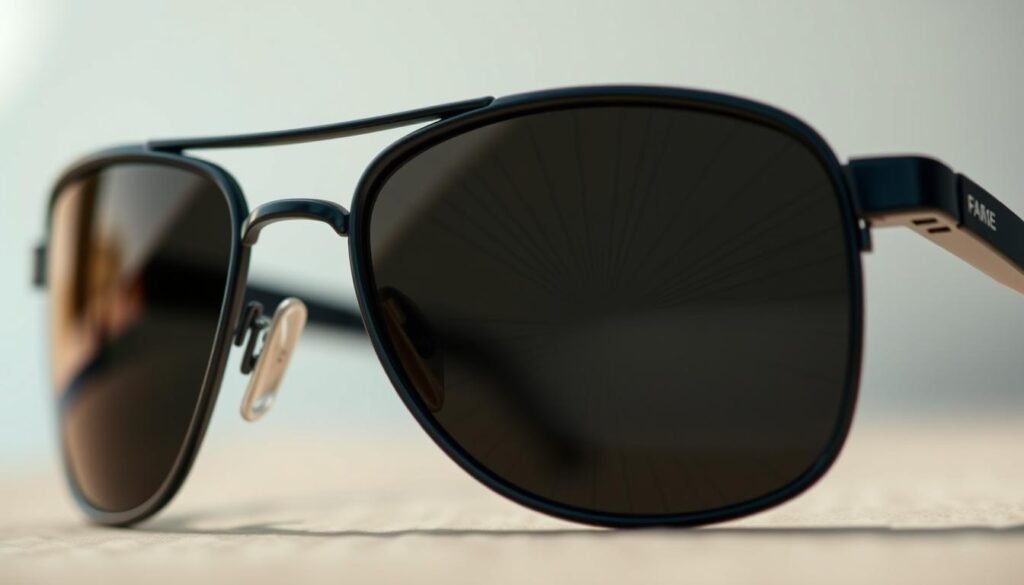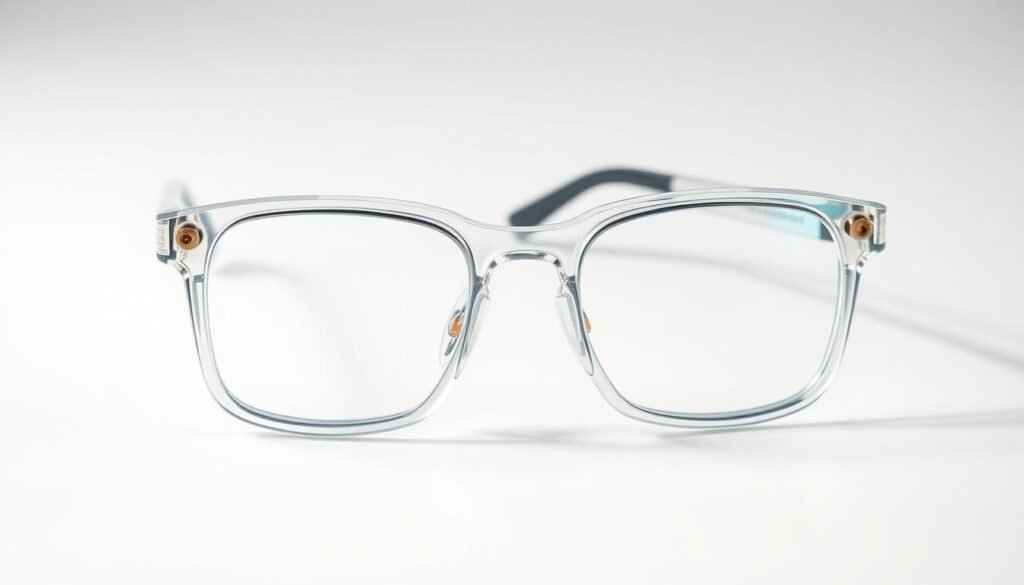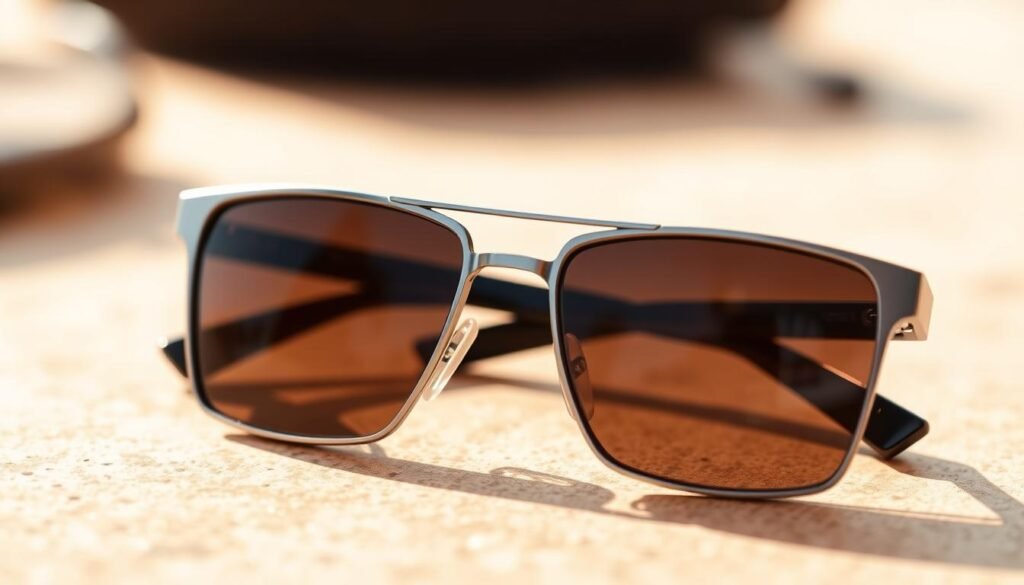Finding the right eye-friendly sunglasses can make a significant difference in your daily comfort. Many people experience eye strain or discomfort due to wearing improper eyewear.
Wearing sunglasses for comfort is not just about style; it’s also about protecting your eyes from harmful UV rays and reducing glare. The right pair can enhance your visual experience, whether you’re driving, hiking, or simply enjoying a day out.
Choosing sunglasses that don’t hurt eyes involves considering factors like lens quality, frame fit, and UV protection. By selecting the right eyewear, you can enjoy the outdoors without compromising your eye health.
Key Takeaways
- Eye-friendly sunglasses reduce eye strain.
- Comfortable eyewear enhances your outdoor experience.
- Proper UV protection is crucial for eye health.
- Choosing the right sunglasses involves considering lens quality and frame fit.
- Protecting your eyes from glare improves visual comfort.
Understanding Eye Discomfort from Sunglasses
Wearing sunglasses is essential for eye protection, but some styles can lead to eye discomfort. Many people experience eye strain or fatigue when wearing certain sunglasses, which can be attributed to various factors.
Common Causes of Eye Strain from Improper Eyewear
Eye strain from sunglasses is often caused by improper eyewear. This can include sunglasses that are not properly fitted, lenses that are not suitable for the wearer’s eyes, or frames that are too tight or too loose. Poorly designed sunglasses can lead to eye fatigue, headaches, and even long-term vision problems. According to experts, “the wrong sunglasses can cause eye strain, which may result in discomfort and fatigue.”
How Poor-Quality Sunglasses Can Damage Your Vision
Poor-quality sunglasses can damage your vision by failing to provide adequate UV protection. Prolonged exposure to UV radiation can lead to serious eye conditions, including cataracts and macular degeneration. Furthermore, low-quality lenses can cause distortion, leading to eye strain and discomfort. As a study highlights, “UV protection is crucial for preventing long-term eye damage.”
The Science Behind Eye-Friendly Sunglasses
The science behind eye-friendly sunglasses involves advanced technologies that protect our eyes from harmful radiation. These technologies are designed to address specific eye care concerns, ensuring that our sunglasses are not just a fashion accessory but a vital tool for maintaining eye health.
UV Protection and Its Importance
UV protection is a critical feature of eye-friendly sunglasses. Prolonged exposure to UV radiation can lead to serious eye conditions such as cataracts and macular degeneration. Sunglasses that offer UV protection block 99-100% of UVA and UVB rays, safeguarding the eyes from damage. When selecting sunglasses, look for those that provide comprehensive UV protection to ensure your eyes remain healthy.
Blue Light Filtering Technology
In addition to UV protection, blue light filtering technology is another important feature of eye-friendly sunglasses. Blue light, emitted by digital devices, can cause eye strain and discomfort. Sunglasses with blue light filtering lenses can reduce this strain, making them ideal for individuals who spend a lot of time in front of screens. This technology enhances visual comfort and reduces the risk of long-term eye damage.
Key Features of Sunglasses That Don’t Hurt Your Eyes
Eye comfort and protection go hand-in-hand with the right sunglasses features. When shopping for sunglasses, it’s essential to consider several key factors that contribute to overall eye comfort and protection.
Polarization Benefits
Polarized sunglasses are designed to reduce glare from reflective surfaces like water, snow, and glass. This feature is particularly beneficial for individuals who spend a lot of time outdoors, whether driving, fishing, or engaging in sports. By minimizing glare, polarized lenses enhance visual clarity and reduce eye strain.
Lens Material and Quality
The material and quality of the lenses are crucial for both comfort and protection. High-quality lenses are made from materials that are impact-resistant and provide excellent optical clarity. Polycarbonate and Trivex lenses are popular choices due to their durability and lightweight properties. Additionally, lenses with UV400 protection block 99-100% of UVA and UVB rays, safeguarding your eyes from harmful ultraviolet radiation.
| Lens Material | Benefits |
|---|---|
| Polycarbonate | Impact-resistant, lightweight |
| Trivex | Excellent optical clarity, thin, and lightweight |
Frame Design and Fit
The design and fit of the frame play a significant role in the overall comfort of the sunglasses. Frames that are too tight can cause pressure on the temples and nose, while those that are too loose may slip down the nose. Adjustable nose pads and flexible temple tips can enhance the fit, ensuring that the sunglasses stay in place without causing discomfort. Moreover, frames made from lightweight materials can reduce the overall weight on the face.
By considering these key features—polarization benefits, lens material and quality, and frame design and fit—you can find sunglasses that not only protect your eyes but also provide all-day comfort.
Understanding UV Protection Ratings
When it comes to protecting your eyes, understanding UV protection ratings is crucial for choosing the right sunglasses. UV protection is not just a feature; it’s a necessity for safeguarding your vision against the harmful effects of ultraviolet rays.
The level of UV protection offered by sunglasses is measured through various ratings and standards. Two prominent standards are UV400 and Category 3 protection. Understanding these standards is key to ensuring your sunglasses provide the necessary protection.
UV400 vs. Category 3 Protection
UV400 protection refers to the ability of the lens to block UV rays with wavelengths up to 400 nanometers, covering the entire UVA and UVB spectrum. This standard is widely recognized and recommended for its comprehensive protection.
Category 3 protection, on the other hand, is part of the European standard for sunglasses. It signifies a high level of UV protection, though the specific requirements can vary slightly from UV400. Category 3 lenses are designed to provide a high level of protection suitable for most outdoor activities.
- UV400: Blocks UV rays up to 400nm, covering UVA and UVB.
- Category 3: High level of UV protection, suitable for bright conditions.
FDA and CE Standards for Sunglasses
In the United States, the FDA regulates sunglasses, ensuring they meet certain safety standards, including adequate UV protection. The FDA requires that sunglasses provide a certain level of UVA and UVB protection, though the specific UV protection rating (like UV400) is not always mandated.
The CE marking is a certification mark that indicates compliance with the health, safety, and environmental protection standards for products sold within the European Economic Area (EEA). For sunglasses, CE marking ensures compliance with EU standards, including those related to UV protection.
When choosing sunglasses, look for both UV400 protection and compliance with local standards (such as FDA in the U.S. or CE in Europe) to ensure you’re getting the best possible protection for your eyes.
Choosing the Right Lens Color for Eye Comfort
Selecting the perfect lens color for your sunglasses can significantly enhance your visual comfort and overall eye health. Different lens colors are designed to serve various purposes, from reducing glare to enhancing contrast.
Gray Lenses for True Color Perception
Gray lenses are ideal for those who want to maintain true color perception. They reduce brightness without distorting colors, making them suitable for everyday wear. Gray lenses are particularly beneficial for driving and outdoor activities.
Brown and Amber for Enhanced Contrast
Brown and amber lenses enhance contrast and depth perception, making them popular among outdoor enthusiasts. They are particularly useful in varying light conditions, such as during sunrise or sunset, by reducing glare and enhancing visual clarity.
Green Lenses for Reduced Eye Strain
Green lenses offer a balance between glare reduction and color accuracy. They can reduce eye strain in bright conditions and are a good choice for activities like golfing or fishing, where visual clarity is crucial.
Yellow and Rose Tints for Specific Conditions
Yellow and rose tints are often used for specific visual needs, such as enhancing contrast in low-light conditions or reducing blue light exposure. Yellow lenses can be particularly helpful for night driving or in foggy conditions, while rose tints can reduce eye strain from digital screens.
By choosing the right lens color, you can significantly improve your eye comfort and visual performance. Whether you’re looking for true color perception, enhanced contrast, or reduced eye strain, there’s a lens color designed to meet your needs.
Which Sunglasses Don’t Hurt Your Eyes: Top Brands
When it comes to sunglasses that don’t hurt your eyes, several top brands stand out for their innovative technologies and commitment to eye comfort. These brands have developed advanced lens technologies that not only protect your eyes but also enhance your visual experience.
Maui Jim’s PolarizedPlus2® Technology is renowned for its exceptional clarity and color fidelity. This technology combines polarization with a special lens treatment to reduce glare and enhance color contrast, making it ideal for water sports and driving. The PolarizedPlus2® lenses are designed to be highly effective in a variety of lighting conditions, ensuring that your eyes remain comfortable throughout the day.
Maui Jim’s PolarizedPlus2® Technology
Maui Jim’s innovative approach to lens technology includes their proprietary PolarizedPlus2® lenses, which offer superior glare reduction and color enhancement. This technology is particularly beneficial for activities like fishing and boating, where glare from the water can be a significant issue.
Costa Del Mar’s 580 Lens Technology
Costa Del Mar’s 580 Lens Technology is designed to provide excellent color clarity and contrast, making it a favorite among anglers and outdoor enthusiasts. The 580 lenses are crafted to filter out specific wavelengths of light that can interfere with visual clarity, resulting in sharper, more vibrant visuals.

Oakley’s Prizm™ Lens Technology
Oakley’s Prizm™ Lens Technology is engineered to enhance visual clarity and contrast in various environments. Prizm™ lenses are designed to highlight specific colors and details, making them particularly useful for athletes who need to see subtle changes in their surroundings, such as road cyclists or skiers.
Ray-Ban’s Chromance Lenses
Ray-Ban’s Chromance Lenses offer advanced color enhancement and visual clarity. These lenses are designed to provide a more natural color perception, reducing eye strain and improving overall visual comfort. Chromance technology ensures that colors remain vibrant and true to life, even in varying light conditions.
| Brand | Lens Technology | Key Benefits |
|---|---|---|
| Maui Jim | PolarizedPlus2® | Glare reduction, enhanced color contrast |
| Costa Del Mar | 580 Lens Technology | Color clarity, contrast enhancement |
| Oakley | Prizm™ | Visual clarity, contrast enhancement |
| Ray-Ban | Chromance | Natural color perception, reduced eye strain |
These top brands are redefining the standards for eye comfort in sunglasses, offering a range of technologies that cater to different needs and preferences. Whether you’re an athlete, an outdoor enthusiast, or simply someone who values eye health, there’s a pair of sunglasses out there that’s designed to keep your eyes comfortable and protected.
Prescription Sunglasses: Comfort Solutions for Vision Correction
Vision correction and sun protection are no longer mutually exclusive thanks to prescription sunglasses. These specialized eyewear solutions cater to individuals who require vision correction, offering both comfort and style.
When it comes to prescription sunglasses, the type of lens is crucial. Single vision lenses are designed for individuals who have the same prescription in both eyes, correcting nearsightedness, farsightedness, or astigmatism. On the other hand, progressive lenses provide a more complex solution, allowing for a gradual transition between different prescriptions within the same lens.
Single Vision vs. Progressive Lenses
Single vision lenses are ideal for those who need correction for a single field of vision. Progressive lenses, however, are better suited for individuals who need multiple prescriptions, such as for distance, intermediate, and near vision.
Adapting to New Prescription Sunglasses
Adapting to new prescription sunglasses can take some time. It’s essential to wear them consistently and give your eyes a few days to adjust. If discomfort persists, consult with an eye care professional.
Sports and Activity-Specific Sunglasses
Whether you’re hitting the slopes or the beach, activity-specific sunglasses are engineered to meet the demands of your favorite sports. These specialized sunglasses are designed to enhance performance, provide comfort, and protect your eyes from various environmental factors.
Water and Beach Activities
For water and beach activities, sports sunglasses with polarized lenses are a must-have. They reduce glare from the water’s surface, enhancing visibility and reducing eye strain. Brands often use lightweight, durable materials to ensure the sunglasses stay in place even during intense water sports.
Mountain and Snow Sports
In mountain and snow sports, sunglasses for mountain sports offer protection against UV rays, which are intensified by snow reflection. Many models feature photochromic lenses that adjust to changing light conditions, ensuring optimal visibility on the slopes.
Running and Road Sports
For runners and cyclists, running sunglasses are designed to be lightweight and aerodynamic, minimizing wind resistance. They often feature interchangeable lenses to adapt to different lighting conditions, and some models include features like ventilation to prevent fogging.
By choosing the right sports sunglasses for your activity, you can enjoy enhanced performance, comfort, and eye protection. Whether you’re engaging in water sports, mountain activities, or running, there’s a pair designed to meet your needs.
Preventing Headaches and Pressure Points
The right pair of sunglasses can make all the difference in preventing headaches and ensuring all-day comfort. When it comes to enjoying the outdoors without discomfort, the design and fit of your sunglasses play a crucial role.
Ill-fitting sunglasses can lead to a variety of issues, including headaches and pressure points around the temples and nose. Ensuring a proper fit is key to comfort.
Proper Frame Sizing and Adjustment
One of the primary factors in preventing discomfort is ensuring that your sunglasses are properly sized and adjusted. Frames that are too tight can cause pressure points, while those that are too loose may slip down your nose, causing you to adjust them frequently and potentially leading to headaches.
To achieve the perfect fit, consider the following:
- Choose frames that fit your face shape and size.
- Adjust the arms to ensure they sit comfortably on your ears.
- Make sure the nose pads are comfortable and don’t put too much pressure on your nose.

Lightweight Materials for All-Day Comfort
The materials used in your sunglasses can also significantly impact comfort. Lightweight materials can reduce the pressure on your nose and ears, making your sunglasses more comfortable to wear for extended periods.
Many modern sunglasses are made with lightweight yet durable materials, such as acetate or titanium. These materials not only provide comfort but also ensure that your sunglasses remain stylish and functional.
“The key to comfortable sunglasses lies in their ability to balance style with functionality, ensuring that they are both protective and comfortable to wear.” –
How to Test Sunglasses for Comfort Before Buying
Before buying sunglasses, it’s crucial to test them for comfort to ensure a pleasant wearing experience. Comfort is key to enjoying your sunglasses, whether you’re using them for fashion or function.
In-Store Testing Techniques
When trying on sunglasses in-store, take a few moments to assess their comfort. Wear them for a few minutes to see how they feel. Check if the frames sit comfortably on your nose and ears, and if the weight is evenly distributed.
- Adjust the frames to fit your face properly.
- Check for any pressure points or slipping.
- Ensure the lenses are properly aligned with your eyes.
What to Look for During the First Wear
During the first wear, pay attention to any discomfort or issues. If you experience headaches or eye strain, it may be a sign that the sunglasses don’t fit properly or are not suitable for your eyes.
| Comfort Factor | What to Check |
|---|---|
| Frame Fit | Ensure the frames don’t slip or press too hard on your nose or ears. |
| Lens Quality | Check for any distortion or discomfort caused by the lens material. |
By following these steps, you can ensure that your sunglasses are not only stylish but also comfortable to wear.
Sunglasses for Specific Eye Conditions
Individuals with specific eye conditions often face challenges in finding suitable sunglasses that provide both comfort and protection. Certain eye conditions require more than just UV protection; they demand specialized features in sunglasses to alleviate discomfort and protect the eyes effectively.
Options for Light Sensitivity and Migraines
For individuals with light sensitivity or migraines, sunglasses with specific lens tints and technologies can offer significant relief. FL-41 tinted lenses, for example, are known to help reduce migraine frequency and severity by filtering out certain wavelengths of light.
Lens materials and coatings can also play a crucial role. Polarized lenses can reduce glare, which is often a trigger for migraines. Additionally, lenses with blue light filtering technology can help reduce eye strain caused by prolonged exposure to digital screens.
| Lens Feature | Benefit |
|---|---|
| FL-41 Tinted Lenses | Reduces migraine frequency and severity |
| Polarized Lenses | Reduces glare, a common migraine trigger |
| Blue Light Filtering | Reduces eye strain from digital screens |
Solutions for Dry Eye Syndrome
For those suffering from dry eye syndrome, certain features in sunglasses can help alleviate symptoms. Wrap-around frames can protect the eyes from wind, a common irritant for dry eyes. Additionally, moisture chamber inserts can be used to retain moisture around the eyes, providing further relief.
It’s also beneficial to look for sunglasses with anti-reflective coatings to minimize glare and reduce eye strain. Some brands offer specialized dry eye relief lenses that are designed to work in conjunction with other dry eye treatments.
Conclusion
Selecting the right sunglasses is crucial for eye comfort and overall eye health. As discussed, factors such as UV protection, lens material, and frame design play a significant role in determining the quality of your sunglasses.
Brands like Maui Jim, Costa Del Mar, Oakley, and Ray-Ban offer high-quality sunglasses that prioritize eye comfort. When choosing your next pair of sunglasses, consider the features that matter most, such as polarization, lens color, and proper fit.
By investing in sunglasses that provide excellent eye comfort, you can enjoy the outdoors while protecting your vision. Whether you’re engaging in water sports, driving, or simply spending time outdoors, the right sunglasses can make all the difference.

